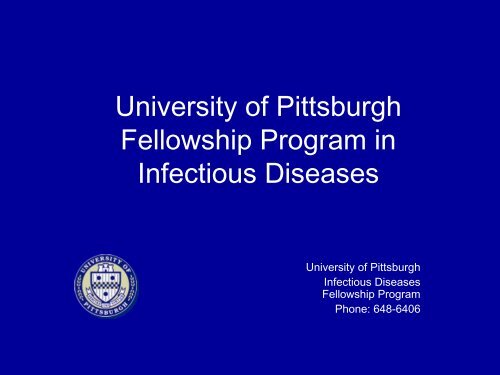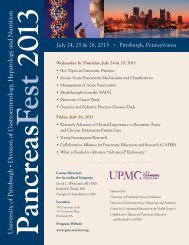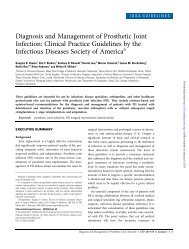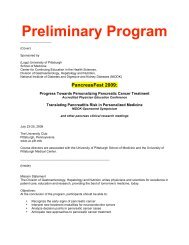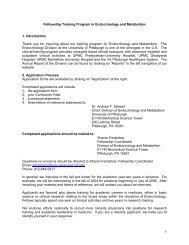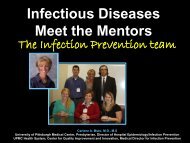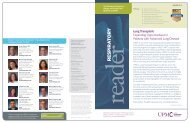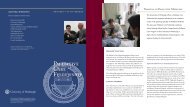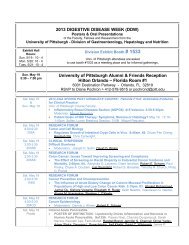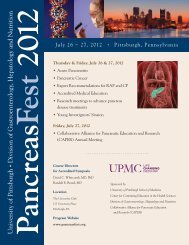University of Pittsburgh Fellowship Program in Infectious Diseases
University of Pittsburgh Fellowship Program in Infectious Diseases
University of Pittsburgh Fellowship Program in Infectious Diseases
- No tags were found...
You also want an ePaper? Increase the reach of your titles
YUMPU automatically turns print PDFs into web optimized ePapers that Google loves.
<strong>University</strong> <strong>of</strong> <strong>Pittsburgh</strong><strong>Fellowship</strong> <strong>Program</strong> <strong>in</strong><strong>Infectious</strong> <strong>Diseases</strong><strong>University</strong> <strong>of</strong> <strong>Pittsburgh</strong><strong>Infectious</strong> <strong>Diseases</strong><strong>Fellowship</strong> <strong>Program</strong>Phone: 648-6406
Mission Statement• The mission <strong>of</strong> our fellowship program is to tra<strong>in</strong>the future leaders <strong>of</strong> <strong>in</strong>fectious diseases <strong>in</strong>academic and cl<strong>in</strong>ical medic<strong>in</strong>e and research.• We are committed to the mission <strong>of</strong> provid<strong>in</strong>gstate-<strong>of</strong>-the-art health care that is <strong>of</strong> the highestquality, compassionate, comprehensive andeasily accessible to patients with a variety <strong>of</strong><strong>in</strong>fectious diseases.
Mission Statement• We provide excellence <strong>in</strong> mentor<strong>in</strong>g and tra<strong>in</strong><strong>in</strong>gfellows, residents, and medical students tobecome leaders <strong>in</strong> the care <strong>of</strong> patients with<strong>in</strong>fectious diseases and leaders <strong>in</strong> the discovery<strong>of</strong> new knowledge <strong>in</strong> basic, translational, andcl<strong>in</strong>ical research.• The Division <strong>of</strong> <strong>Infectious</strong> <strong>Diseases</strong> is wellknownfor its cl<strong>in</strong>ical and research excellence <strong>in</strong>:– HIV/AIDS– Medical mycology– Molecular microbiology and epidemiology– Infection control– Transplant <strong>in</strong>fectious diseases
Statements from the Fellows•“Very strong <strong>Fellowship</strong> program that<strong>of</strong>fers a diverse experience <strong>in</strong> both cl<strong>in</strong>icaland research tra<strong>in</strong><strong>in</strong>g”.•“Well-respected caliber <strong>of</strong> tra<strong>in</strong><strong>in</strong>g. Weappreciate the Division’s commitment toexcellence <strong>in</strong> teach<strong>in</strong>g and assur<strong>in</strong>g thatwe receive rigorous research tra<strong>in</strong><strong>in</strong>g <strong>in</strong>order to succeed <strong>in</strong> academic medic<strong>in</strong>e”.
Statements from the Fellows•“Excellent ID faculty who provide us with abalanced view <strong>of</strong> cl<strong>in</strong>ical <strong>in</strong>fectiousdiseases and br<strong>in</strong>g with them theirparticular research focus or <strong>in</strong>terests toteach<strong>in</strong>g rounds”.•“I’m amazed at the amount <strong>of</strong> teach<strong>in</strong>gand the concern the fellows get from theattend<strong>in</strong>gs. They really want to make surewe succeed <strong>in</strong> our future plans.”
Outstand<strong>in</strong>g <strong>in</strong> Teach<strong>in</strong>g• The division <strong>of</strong> <strong>Infectious</strong> <strong>Diseases</strong> hasbeen recognized for its outstand<strong>in</strong>gteach<strong>in</strong>g <strong>of</strong> the medical students, residentsand fellows, and nom<strong>in</strong>ated for variousprestigious teach<strong>in</strong>g awards.
Outstand<strong>in</strong>g <strong>in</strong> Teach<strong>in</strong>g• Kar<strong>in</strong> Byers, MD– Recipient <strong>of</strong> the “2008 Cl<strong>in</strong>ical Educator <strong>of</strong> the Year"award presented to faculty who consistently providesoutstand<strong>in</strong>g cl<strong>in</strong>ical education <strong>in</strong> the elective coursesett<strong>in</strong>g for medical students <strong>of</strong> the <strong>University</strong> <strong>of</strong><strong>Pittsburgh</strong> School <strong>of</strong> Medic<strong>in</strong>e.• Peter Veldkamp, MD, MS– Recipient <strong>of</strong> the “2007 Outstand<strong>in</strong>g Teach<strong>in</strong>gAttend<strong>in</strong>g” award from the <strong>University</strong> <strong>of</strong> <strong>Pittsburgh</strong>,Department <strong>of</strong> Medic<strong>in</strong>e Interns– Recipient <strong>of</strong> the “2008 Excellence <strong>in</strong> EducationAward” as Course Director, presented by theDepartment <strong>of</strong> Medic<strong>in</strong>e Class <strong>of</strong> 2011.
Outstand<strong>in</strong>g <strong>in</strong> Teach<strong>in</strong>g• Cornelius J. Clancy, MD– Recipient <strong>of</strong> “Excellence <strong>in</strong> Teach<strong>in</strong>g Medical Students” award <strong>in</strong>2007 while faculty at <strong>University</strong> <strong>of</strong> Florida. Dr. Clancy wasrecruited to <strong>University</strong> <strong>of</strong> <strong>Pittsburgh</strong> <strong>in</strong> November 2007 asDirector <strong>of</strong> Mycology Research Unit• M<strong>in</strong>h-Hong Nguyen, MD– Recipient <strong>of</strong> “Excellence <strong>in</strong> Teach<strong>in</strong>g Residents and Fellows”and “Excellence <strong>in</strong> Teach<strong>in</strong>g Medical Students” <strong>in</strong> 2007 whilefaculty at <strong>University</strong> <strong>of</strong> Florida. Dr. Nguyen was recruited to<strong>University</strong> <strong>of</strong> <strong>Pittsburgh</strong> <strong>in</strong> November 2007 as the Director <strong>of</strong>Transplant ID <strong>Program</strong> and Antibiotic Management <strong>Program</strong>.– Recipient <strong>of</strong> the “Thomas Sydenham Dist<strong>in</strong>guished Cl<strong>in</strong>icalTeach<strong>in</strong>g Award” presented by the <strong>University</strong> <strong>of</strong> FloridaDepartment <strong>of</strong> Medic<strong>in</strong>e to the faculty member who bestrepresents the ideals <strong>of</strong> an outstand<strong>in</strong>g Academic Internist.
Education venues• Weekly ID core curriculum lectures• Weekly journal club• Weekly ID Grand Rounds:– Microbiology photo quiz– Case presentation• Thrice-monthly HIV/AIDS rounds– Antimicrobial resistance– Morbidity and Mortality• Bi-annually Research-<strong>in</strong>-Progress• Bi-monthly Transplant <strong>Infectious</strong> <strong>Diseases</strong>journal club (optional)
Outstand<strong>in</strong>g cl<strong>in</strong>ical experienceYear 1:• <strong>Infectious</strong> <strong>Diseases</strong>consultation service: 10months– UPMC General <strong>Infectious</strong><strong>Diseases</strong> Consult Service– VA Medical Center <strong>Infectious</strong><strong>Diseases</strong> Consult Service– Surgical <strong>Infectious</strong> <strong>Diseases</strong>Consult Service• Microbiology LaboratoryRotation: 1 month• Infection Control Rotation: 1month• Ambulatory <strong>Infectious</strong><strong>Diseases</strong> Cl<strong>in</strong>ic: 1/2 day perweekYear 2:• Biomedical Research Tra<strong>in</strong><strong>in</strong>g:9 months• Transplant <strong>Infectious</strong> <strong>Diseases</strong>Consult Service: 1 month• Surgical <strong>Infectious</strong> <strong>Diseases</strong>Consult Service: 2 weeks• Ambulatory HIV/AIDS Cl<strong>in</strong>ic:1/2 day per weekYear 3 (optional):• Biomedical Research Tra<strong>in</strong><strong>in</strong>g:11 months• Ambulatory HIV/AIDS Cl<strong>in</strong>ic:1/2 day per week
Diversity <strong>of</strong> Cl<strong>in</strong>ical Cases• UPMC at the <strong>University</strong> <strong>of</strong> <strong>Pittsburgh</strong> is a tertiarycare referral hospital with a unique strategy <strong>of</strong>comb<strong>in</strong><strong>in</strong>g cl<strong>in</strong>ical and research excellencetranslates <strong>in</strong>to state-<strong>of</strong>-the-art, evidence-basedpatient care and advances <strong>in</strong> biotechnology• It is a renowned center <strong>in</strong> transplantation,cancer, neurosurgery, orthopedic surgery,endocr<strong>in</strong>ology, otolaryngology, rheumatology,gastroenterology, nephrology, pulmonology,geriatric care, cardiology and cardiac surgery,psychiatry, rehabilitation and urology
Diversity <strong>of</strong> Cl<strong>in</strong>ical Cases• The fellows encounter bread and butter casesas well as exotic cases <strong>in</strong>:– Bacteriology– Mycology–Virology– Parasitology• The fellows also round at the VA Medical Centerwhere they encounter a variety <strong>of</strong> communityacquired<strong>in</strong>fections and <strong>in</strong>fectious complications<strong>of</strong> diabetes mellitus and other chronic medicaldiseases, solid organ cancer andtransplantation.
Diversity <strong>of</strong> Cl<strong>in</strong>ical Cases• Microbiology is a major part <strong>of</strong> <strong>in</strong>fectiousdiseases tra<strong>in</strong><strong>in</strong>g.– The general ID service rounds <strong>in</strong> theMicrobiology laboratory prior to go to thepatient’s bed side.– A weekly microbiology quiz is an <strong>in</strong>tegral part<strong>of</strong> fellows’ education.
Recent Weekly Micro Quiz“Sail<strong>in</strong>g to South America”“Imported Fever from Afghanistan”“What the eyes don’t see the heartdoesn’t feel – is it always true?”
Outstand<strong>in</strong>g ResearchOpportunities• The Division <strong>of</strong> <strong>Infectious</strong> <strong>Diseases</strong> has anoutstand<strong>in</strong>g track record <strong>in</strong> tra<strong>in</strong><strong>in</strong>g nextgeneration researchers.• Our recent fellows have been recognized atprestigious national meet<strong>in</strong>gs for the excellence<strong>of</strong> their research, <strong>in</strong>clud<strong>in</strong>g the <strong>Infectious</strong><strong>Diseases</strong> Society <strong>of</strong> America Annual Meet<strong>in</strong>gand the American Society <strong>of</strong> Microbiology’sInterscience Conference on Antimicrobial Agentsand Chemotherapy.
Outstand<strong>in</strong>g ResearchOpportunities5• 59% <strong>of</strong> our fellows <strong>in</strong>the past decade haveassumed academicpositions at majorteach<strong>in</strong>g <strong>in</strong>stitutionsNumber <strong>of</strong>Fellows4321OthersPrivateAcademic01999 2002 2004 2006 2008Graduat<strong>in</strong>g years
Recent Fellows Selected 1 stAuthored Publications• Curry SR, et al. tcdC genotypes associated withsevere TcdC truncation <strong>in</strong> an epidemic cloneand other stra<strong>in</strong>s <strong>of</strong> Clostridium difficile. J Cl<strong>in</strong>Microbiol. 2007;45:2103• Doi Y, et al. Coproduction <strong>of</strong> novel 16S rRNAmethylase RmtD and metallo-beta-lactamaseSPM-1 <strong>in</strong> a panresistant Pseudomonasaerug<strong>in</strong>osa isolate from Brazil. AntimicrobAgents Chemother. 2007;51:852-6.• Doi Y, et al. 16S ribosomal RNA methylation:emerg<strong>in</strong>g resistance mechanism aga<strong>in</strong>stam<strong>in</strong>oglycosides. Cl<strong>in</strong> Infect Dis. 2007;45:88-94.
Fellows Selected 1 st AuthoredPublications• Doi Y, et al. High prevalence <strong>of</strong> metallo-betalactamaseand 16S rRNA methylasecoproduction among imipenem-resistantPseudomonas aerug<strong>in</strong>osa isolates <strong>in</strong> Brazil.Antimicrob Agents Chemother. 2007;51:3388-90.• Doi Y, et al. Identification <strong>of</strong> 16S rRNAmethylase-produc<strong>in</strong>g Ac<strong>in</strong>etobacter baumanniicl<strong>in</strong>ical stra<strong>in</strong>s <strong>in</strong> North America. AntimicrobAgents Chemother. 2007;51:4209-10.
Fellows Selected 1 st AuthoredPublications• Doi Y et al. Escherichia coli isolate coproduc<strong>in</strong>g16S rRNA Methylase and CTX-M-typeextended-spectrum beta-lactamase isolatedfrom an outpatient <strong>in</strong> the United States.Antimicrob Agents Chemother. 2008;52:1204-5.• Doi Y,et al. Community-acquired extendedspectrumbeta-lactamase producers, UnitedStates. Emerg Infect Dis. 2007;13:1121-3.
Fellows Selected 1 st AuthoredPublications• Doi Y, et al. Characterization <strong>of</strong> a naturallyoccurr<strong>in</strong>g class D beta-lactamase fromAchromobacter xylosoxidans. Antimicrob AgentsChemother. 2008;52:1952-6.• Doi Y, et al. Nomenclature <strong>of</strong> plasmid-mediated16S rRNA methylases responsible for panam<strong>in</strong>oglycoside resistance. Antimicrob AgentsChemother. 2008;52:2287-8.• Doi Y, et al. Genetic environment <strong>of</strong> 16S rRNAmethylase gene rmtD. Antimicrob AgentsChemother. 2008;52:2270-2.
Fellows Selected 1 st AuthoredPublications• Bhat SV, et al. Failure <strong>of</strong> current cefepimebreakpo<strong>in</strong>ts to predict cl<strong>in</strong>ical outcomes <strong>of</strong>bacteremia caused by gram-negativeorganisms. Antimicrob Agents Chemother.2007;51:4390-5.• Bhat S, et al. Pseudomonas aerug<strong>in</strong>osa<strong>in</strong>fections <strong>in</strong> the Intensive Care Unit: can theadequacy <strong>of</strong> empirical beta-lactam antibiotictherapy be improved? Int J Antimicrob Agents.2007;30:458-62.
Fellows Selected 1 st AuthoredPublications• Bhat SV, et al. Scedosporium prolificans bra<strong>in</strong> abscess<strong>in</strong> a patient with chronic granulomatous disease:successful comb<strong>in</strong>ation therapy with voriconazole andterb<strong>in</strong>af<strong>in</strong>e. Scand J Infect Dis. 2007;39:87-90.• Peleg AY, et al. Ac<strong>in</strong>etobacter baumannii bloodstream<strong>in</strong>fection while receiv<strong>in</strong>g tigecycl<strong>in</strong>e: a cautionary report.JAntimicrob Chemother. 2007;59:128-31• Pelag AY, et al. Risk factors, cl<strong>in</strong>ical characteristics, andoutcome <strong>of</strong> Nocardia <strong>in</strong>fection <strong>in</strong> organ transplantrecipients: a matched case-control study. Cl<strong>in</strong> Infect Dis.2007;44:1307-14.
Fellows Selected 1 st AuthoredPublications• Silveira et al. Bloodstream <strong>in</strong>fections <strong>in</strong> organtransplant recipients receiv<strong>in</strong>g alemtuzumab: noevidence <strong>of</strong> occurrence <strong>of</strong> organisms typicallyassociated with pr<strong>of</strong>ound T cell depletion. JInfect. 2006;53:241-7.• Silveira F, et al. Pulmonary fungal <strong>in</strong>fections.Curr Op<strong>in</strong> Pulm Med. 2005;11:242-6.• Silveira F, Fujitani S, Paterson DL. Antibioticresistant<strong>in</strong>fections <strong>in</strong> the critically ill adult. Cl<strong>in</strong>Lab Med. 2004;24:329-41.
Conclusion• The ID fellowhip program at UPMCprovides state-<strong>of</strong>-the-art cl<strong>in</strong>ical andresearch tra<strong>in</strong><strong>in</strong>g• Our graduates are qualified to succeed <strong>in</strong>the different venues <strong>of</strong> ID: cl<strong>in</strong>ical care,cl<strong>in</strong>ical, translational and basic research,<strong>in</strong>fection control, public health
Contact UsPlease contact Kim Barnhart with questions about the <strong>Infectious</strong><strong>Diseases</strong> <strong>Fellowship</strong> <strong>Program</strong>. We appreciate your <strong>in</strong>terest and lookforward to receiv<strong>in</strong>g your applicationKim Barnhart, M.Ed.Education & <strong>Fellowship</strong> Coord<strong>in</strong>ator<strong>University</strong> <strong>of</strong> <strong>Pittsburgh</strong>Dept <strong>of</strong> Medic<strong>in</strong>e, Div <strong>of</strong> <strong>Infectious</strong> <strong>Diseases</strong>Falk Medical Bldg, Suite 3A3601 Fifth Avenue<strong>Pittsburgh</strong>, PA 15213-2582Tele: 412-648-6406; Fax: 412-648-6399Email: kib9@pitt.edu


